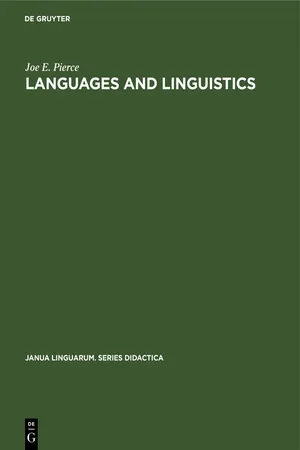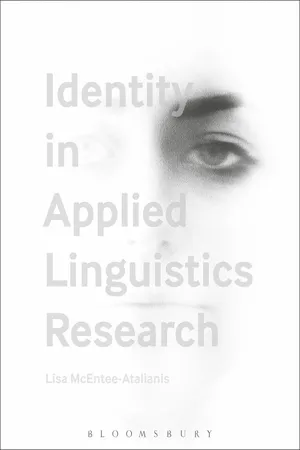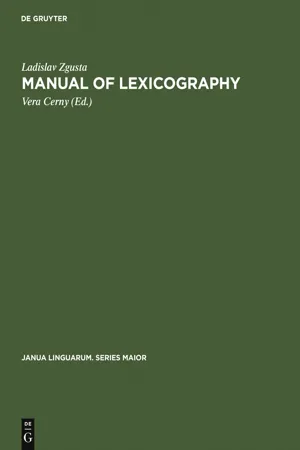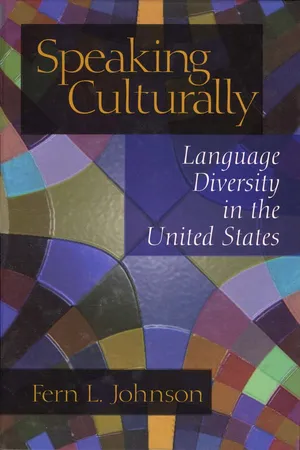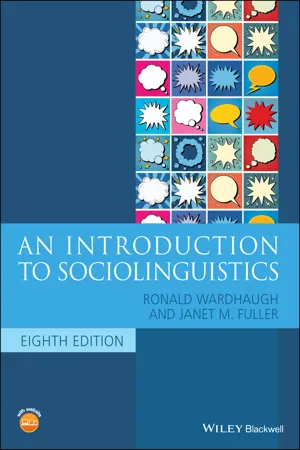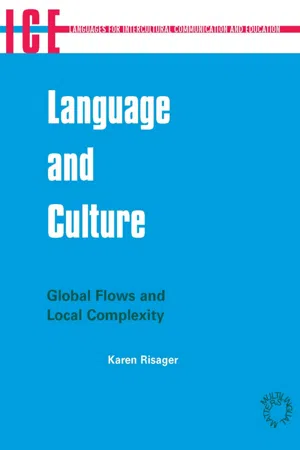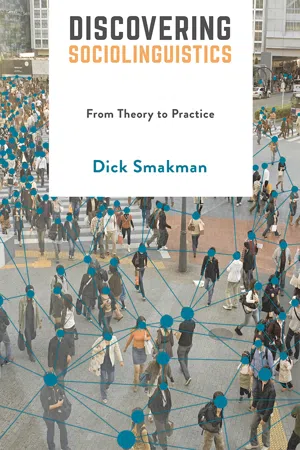Languages & Linguistics
Idiolect
Idiolect refers to the unique linguistic patterns and characteristics of an individual's speech. It encompasses the distinct vocabulary, grammar, pronunciation, and intonation that a person uses to communicate. Idiolect is shaped by a person's background, experiences, and social environment, making it a highly personalized aspect of language.
Written by Perlego with AI-assistance
8 Key excerpts on "Idiolect"
- eBook - PDF
Languages and linguistics
An introduction
- Joe E. Pierce(Author)
- 2019(Publication Date)
- De Gruyter Mouton(Publisher)
Another way to study a language would be to create one description of the Idiolect of one informant at a given time and assume that this were representative of the language as a whole, or that the speech of that person was 'good' English in some unexplainable way. Far too much linguistic and gramma-6 82 tical research has been of exactly this type, with the scholar utilizing his own speech as a model for the analysis, despite the fact that we all know that there are vast dif-ferences from speaker to speaker, region to region, etc. A clear distinction should be made here between a situation in which there are a few remaining speakers of a dying language, where a description of the speech of one of them will suffice for a study of the historical relationships of the language, and a situation wherein one is dealing with a major world language, such as English, and the scholars wish to determine just what the language is and how it works for the purpose of teaching it in the public schools. In the former case the study of one informant will yield sufficient information for scientific purposes, but in the latter it obviously will not. Unlike an Idiolect, which has clearly definable boundaries, i.e. a single individual is a discreet unit in the real world, a dialect is not so easily described. To begin with, a dialect consists, by definition, of a group of Idiolects which are similar to each other in certain ways which are different from other groups of Idiolects of the language in question in certain other ways. The greatest problem is that since no two speakers speak alike, there is a gradual shading off of differences in many cases and one is hard put to define the sphere of influence of any particular dialect. Further, one is not clear as to how much difference there needs to be before two groups can be considered to be different LANGUAGES rather than different dialects of the same language. - eBook - ePub
- Lisa McEntee-Atalianis(Author)
- 2018(Publication Date)
- Bloomsbury Academic(Publisher)
CHAPTER TWO Linguistic IdiosyncrasyIntroductionAll talk displays its speaker’s individual voice. This is necessary because self-expression is necessary: no matter how much a society may value conformity or define people in relationship to others, individuals must on some level express individuated selves.In order to do this, speakers must do things with language that other speakers do not do. Each speaker must, quite literally, be idiosyncratic.BARBARA JOHNSTONE (1996: 187)An enduring debate in sociolinguistics is the relationship between the individual and society. Scholars have questioned how individual patterns of language use relate to community-wide ideologies, language practice and change, with recent studies increasingly attempting to account for the fluidity and variability of language use within and across individuals as aspects of personal and social identity are signalled.The development of variationist sociolinguistics and linguistic anthropology in the 1960s and 1970s, most notably through the quantitative urban dialectological research of William Labov and the development of an approach known as ‘ethnography of speaking’ by anthropologists Dell Hymes and John Gumperz, made variation in linguistic performance within speech communities an important object of study. Since the early identification of stratified patterns of language use in social groups on the east coast of the United States (Labov) and language variation in the multilingual nations of India and Norway (Gumperz and Hymes), variationist research has developed significantly and with it interest in idiosyncratic language use and identity.In this chapter, we focus on selective studies that have taken the individual and idiosyncratic language use as their primary object of study. We begin with a review of the historical treatment of identity within traditional variationist sociolinguistics and end with a consideration and description of selective contemporary studies of individual variation and style which adopt a phenomenological approach with nuanced analytical specificity. We begin with the work of Le Page and Tabouret-Keller (1985), who in their investigation of postcolonial multilingual communities took idiosyncratic language use as their analytic foci in an investigation of variation, observing how a community or social group is constructed through individual linguistic ‘acts of identity’. We next consider how linguistic personae accrete (Rauniomaa 2003) via the particularities of individual language style and stance drawing on the concepts of individual ‘voice’ and ‘lingual biographies’ (Johnstone 1996). We finally review concepts such as language repertoires, rational choice/strategy and extend our discussion of style, focusing on more recent work which draws on the models of indexicality and enregisterment. First, however, we situate our discussion within the field of variationist sociolinguistics. - eBook - PDF
- Ladislav Zgusta, Vera Cerny(Authors)
- 2010(Publication Date)
- De Gruyter Mouton(Publisher)
But on the other hand, it would be wrong to suppose that Idiolects are absolutely different; in such a case, the speakers would not understand one another. The Idiolects of different speakers of the same language are largely identical, but there are differences as well. If we observe the Idiolects of speakers of the same language who have lived together since their childhood in a closed geographical area, we usually perceive (1) a basic identity of the Idiolects with the Idiolects of other speakers of the same language from other areas (otherwise it would not be one language), (2) some isolated features which are to be found in single Idiolects only and which render them individual (otherwise they would not be separate Idiolects), and (3) some features which alone or in specific groups are neither individual nor observable in the whole language, but which are typical just for that area, and are the cause that it is, within the language in question, distinguished from other similar areas. The form of language spoken in such an area is then called a dialect. 9 9 It is not necessary nor usual to specify geographical dialects, but it is possible; the specifi-cation has value when some authors speak about social dialects, i.e. slangs, argots, cultivated languages, restricted languages, etc., so that there is a contradistinction. VARIATION IN LANGUAGE 169 In some areas, the boundaries between languages are rather sharp (at least linguistically, even if there is a geographical zone where the two languages are interspersed) and it is self-evident to which of the neighbouring languages a concrete dialect belongs. In other areas, however, the local dialect belongs. In other areas, however, the local dialects are rather similar but some of them are considered variants of one of the neighbouring languages, and some as variants of the other. - eBook - PDF
Speaking Culturally
Language Diversity in the United States
- Fern L. Johnson(Author)
- 1999(Publication Date)
- SAGE Publications, Inc(Publisher)
Obviously, attribution of meaning then frames subsequent verbal (and physical) action. The Language System in Its Communicative Contexts 39 Analysis of pragmatics as a language system helps us understand many of the ways in which language-in-use leads to communication difficulties between individuals who are members of different speech communities. Dialects and Registers for Language Use Language situates identities, which can be understood in the metaphoric statement, You are what you speak. What a person speaks generally reveals two important dimensions, that of identity and that of situated activity. Dialects and Identities The term dialect refers to the variety of language that is spoken based on a person's social identity, for example, social status, educational attainment, ethnicity, race, regional background, and native language. For a dialect to exist, the language patterns for a group of people must be distinctive in contrast to those patterns found in other groups. The boundaries between one dialect and another are made up of bundles of isoglosses—those features that mark the distinctiveness. Dialects are linguistically patterned by phonology, syntax, and lexicon and morphology—alone or in combination. Taking regional dialects as an exam-ple, variations in the phonological systems typical of speakers from southern Texas and upper Maine are recognizable to most people, whereas lexical differences may be less well understood, as in the case of the word used to refer to a carbonated beverage, which is soda in the Northeast, tonic in some parts of eastern New England, and pop just about everyplace else. Phonologi-cal differences within the same native language can create communication problems or misinterpretations. The speech of most whose origins are in the Caribbean islands will systematically delete the -g from the -ing endings of words, producing doin and wonderin rather than doing and wondering, even in formal contexts. - eBook - PDF
- Ronald Wardhaugh, Janet M. Fuller(Authors)
- 2021(Publication Date)
- Wiley-Blackwell(Publisher)
Languages, Communities, and Contexts Part I An Introduction to Sociolinguistics, Eighth Edition. Ronald Wardhaugh and Janet M. Fuller. © 2021 John Wiley & Sons Ltd. Published 2021 by John Wiley & Sons Ltd. Companion website: www.wiley.com/go/wardhaugh8e 2 We stated in the introductory chapter that the concept of language is considered by many sociolinguists to be an ideological construct. Further, we noted that all languages exhibit internal variation, that is, each language exists in a number of varieties and is in one sense the sum of those varieties. We use the term variety as a general term for a way of speaking; this may be something as broad as Standard English, or a variety defined in terms of loca- tion and social class (e.g., ‘working-class New York City speech’), or something defined by its function or where it is used, such as ‘legalese.’ In the following sections, we will explore these different ways of specifying language varieties and how we define the terms ‘lan- guage’ and ‘dialect’ (regional and social). We will also address how the associations between language and social meaning develop and are used in communicating in different speech contexts. What is a Language? What do we mean when we refer to a language or, even more important, the idea of mixing languages? As we will discuss further in chapters 8 and 9, recent research has coined many new terms to describe what has traditionally been called multilingualism – ‘(trans)lan- guaging,’ ‘metrolingualism,’ ‘heteroglossia.’ These terms reflect the idea that languages are ideological constructs; while we (usually) have names for different ways of speaking and can describe their features, in practice linguistic boundaries may be fluid. - eBook - PDF
Language and Culture
Global Flows and Local Complexity
- Karen Risager(Author)
- 2006(Publication Date)
- Multilingual Matters(Publisher)
Chapter 6 A Sociolinguistic View of Language Introduction In this chapter I start off with the fundamental view of language. I describe what I conceive to be the two ‘natural’ loci of language, linguistic practice and linguistic resources, placing these in relation to an ‘artificial’ locus: the discursive, metalinguistic construction of the language system. An analysis of the relationship between language and culture must there-fore start with a basic distinction being made between three points of view concerning language: a sociological, a psychological and a system-oriented view. Linguistic Practice Linguistic practice as acts of identity Among the various functions of linguistic practice which, along with Halliday, one can sum up as the interpersonal, the ideational and the textual metafunction, I would like here to emphasise an aspect of the inter-personal, namely linguistic acts as acts of identity. I would refer to the work of the sociolinguists Le Page and Tabouret-Keller on linguistic acts of identity in their book Acts of Identity (1985). Le Page and Tabouret-Keller worked in particular in the Creole-speaking Caribbean area and among West Indian groups in London. In these distinctly multilingual contexts, they have studied the factors that influence the choice of language by various individuals as well as the choice of pronunciation, grammar, etc. in connection with various types of contact and in various ethno-cultural contexts. This focuses on the symbolic value of language choice and its significance for the ongoing constitution of identity in the various contexts. Linguistic practice is seen as ‘a series of acts of identity in which people reveal both their personal identity and their search for social roles’ (Le Page & Tabouret-Keller, 1985: 14, italics in the original). - eBook - PDF
Language in Education
Social Implications
- Rita Elaine Silver, Soe Marlar Lwin(Authors)
- 2013(Publication Date)
- Bloomsbury Academic(Publisher)
It can be harder to see that such Acts of Identity are happening when only one language is involved. Nevertheless, speakers use a range of pronunciations, words and LANGUAGE IN EDUCATION 82 grammatical structures in order to signal to others (they hope) who they are and who they want to be. And who they are and want to be varies from time to time and place to place. We want to be different people for different people. This approach to variation can be called identity sociolinguistics : Eckert (2008) calls it the Third Wave of sociolinguistics – Labov being the first – but identity sociolinguistics has developed at the same time as Labovian sociolinguistics, sometimes drawing on insights that did not come from Labovian sociolinguistics. Identity sociolinguists focus on the way in which people (consciously and unconsciously) choose linguistic variants in order to express an identity, either real or assumed. Interviews are seldom used. The data of identity sociolinguistics is usually naturally occurring conversation of people within their normal social settings. Such conversations are recorded and transcribed and then analysed in detail. Analysis may be quantitative, involving calculating the proportion of variants, or it may involve the close examination of a single form in a conversation. The focus is on speakers as active creators of their own identity, and of collective identities. We can even pretend (especially in writing) to be someone we are not. We can be playful, taking on identities that don’t belong to us, either for humour, or to signal that we would like to have membership of a group, or to show the warmth of solidarity. Examples of this are easy to find in both speech and writing, and usually involve using some characteristic words or structures of a dialect other than the standard dialect, which are used alongside the standard dialect. - eBook - PDF
Discovering Sociolinguistics
From Theory to Practice
- Dick Smakman(Author)
- 2017(Publication Date)
- Bloomsbury Academic(Publisher)
Language varieties as a whole are the object of study and how they are grouped. Language planning is part of this level of thinking about lan-guage variation. The latter type of Sociolinguistics looks at individual speak-ers, groups of speakers, separate words and sounds, and other low-level variables, and it tries to find behavioural and other patterns. TODAY’S SOCIOLINGUISTICS 15 place. They are not necessarily economic or political refugees, although that is an often made association. More so than before, migrants maintain close contact with their homeland – digitally and through travel – and mix and mingle with migrants with other ethnic backgrounds and with natives from the country they live in. They use and combine all kinds of styles and languages in a systematic way, depending on the nature of the audience and specific circumstances. KEY CONCEPTS Languaging Research into superdiversity is associated with ‘languaging’, which refers to humans producing language as part of the effort to achieve their goals and deal with complex social activities. It is associated with language learning and language use, where learners engage in language-related activities together and learn to use language that way (Swain 1985 ). In multilingual contexts, ‘translanguaging’ is often used to refer to this phenomenon; multilingual lan-guage users strategically employ multiple semiotic resources to achieve their goals, including their full multilingual repertoire (Garcia and Wei 2014). In the ensuing process of using, mixing, and choosing between languages, a new discourse entity arises, one could say. Reinterpretations of language, communication, and speaker groups Blommaert and Rampton (2011) explained how languages, communication, and speakers may be viewed differently.
Index pages curate the most relevant extracts from our library of academic textbooks. They’ve been created using an in-house natural language model (NLM), each adding context and meaning to key research topics.
